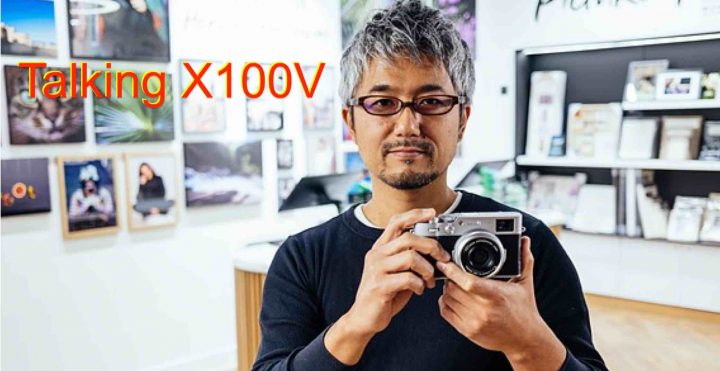Fujifilm Manager Interview: Why no IBIS/OIS on X100V, Expected to Sell Better than X100F, USA Biggest Market and More

DPReview interviewed Fujifilm Chief Designer Maszumi Imai and Senior Manager Shinichiro Udono.
They talk about the Fujifilm X100V.
- Fujifilm X100V: BHphoto / AmazonUS / Adorama / Focuscamera
Here are some excerpts:
Controls
- X100 line is important, as it established the Fujifilm shooting style (the dials, manual controls), and then Fujifilm extended this concept to the entire X-Series
- Fujifilm is always careful to mantain the X100 camera concept, but at the same time to deliver better performance
Market
- X100, X100S and X100T sold similar well
- X100F sold better than previous models
- Fujifilm expects X100V to sell even better than X100F
- biggest market for X100 line was initially Japan, but then USA took over the top spot
- non interchangeable lens X100 can reach a wider market of photo enthusiasts. There’s a big market in the US for photo enthusiasts, especially people who know about the history of film cameras. Those customers really like the X100 line
- The biggest audience is slightly older people, who remember film cameras. But we also see a lot of young people
X100(V) development
- Original X100 was developed in 2 years, from 2009 to 2011
- half the way during development, Fujifilm invented the hybrid viewfinder. So they decided to make a rangefinder camera
- priority in X100V development were viewfinder and lens
- there is no image stabilization to keep the camera smaller. OIS makes lens bigger, IBIS makes camera bigger
- a bigger camera would break the basic concept of the X100V
- it took around two years to develop X100V, because of the new lens. If there would have been changes only in the body, they would have been faster
X100 Future
- in the long term there might be image stabilization on an X100 camera, if Fujifilm can develop it
- Fujifilm would need a very small IBIS to make it fit into X100 body
- style and design of X100 will remain the same for the next 10 years, then Fuji will see what kind of technology is around, but basic concept will remain the same
X100 Inspiration
- when Fujifilm made film cameras we made cameras which shared a similar shooting style to the X100. Cameras like the TX-series, the Klasse, and so on.
- many inside Fujifilm came from film camera division, and the X100 concept was the best to represent what it means to shoot Fujifilm
- The X100 was a homage to traditional film cameras, like the Leica M3
Fujifilm Camera Design Development and about Smartphones and Ai
- When designing a camera, Fujifilm has 2 approaches: the daily work of knowing ‘OK, we need to make a new X100’, where we consider all the technical limitations, and the R&D side will prepare some rough designs and then we decide the final size of the camera.
- But once a year we also conduct a study where we think about the future without considering the current technical limitations. Like a vision exercise. And we create more visionary image mockups. And in a few years, some elements of those image-mockups might end up in final camera
- we decided we could change more in the fifth generation, in terms of concept and design. It’s still based on the X100 core concept, but this time I had freedom to explore more possibilities
- it’s not easy to find the balance between simplicity and control/customization
- I want to make the simplest, purest camera. Simple, and sharp in style
- less buttons does not mean simpler. A smartphone doesn’t have any buttons or dials, but it’s not necessarily the most intuitive interface for shooting photos
- speaking of smartphones, maybe one day they will invent brain-controlled cameras. But I wouldn’t want that. The X100V is the best way to shoot, to create an expression of creativity through photography
- We always look at new technologies, like Ai. We could create a haptic touch interface for buttons and dials and things like that, but it wouldn’t be a good fit for the X-series. That’s why we keep the buttons and dials, and the classic style
You can read the full interview at dpreview.
- Fujifilm X100V: BHphoto / AmazonUS / Adorama / Focuscamera
FujiRumors is on Patreon, Facebook, Instagram, RSS-feed, Youtube, Flipboard and Twitter

